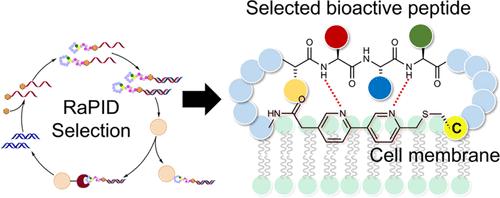Macrocyclic Peptides Closed by a Thioether–Bipyridyl Unit That Grants Cell Membrane Permeability
IF 3.8
Q2 BIOCHEMISTRY & MOLECULAR BIOLOGY
引用次数: 0
Abstract
Membrane permeability is an important factor that determines the virtue of peptides targeting intracellular molecules. By introducing a membrane penetration motif, some peptides exhibit better membrane permeabilities. Previous choices for such motifs have usually been polycationic sequences, but their protease vulnerabilities and modest endosome escapability remain challenging. Here, we report a strategy for macrocyclization of peptides closed by a hydrophobic bipyridyl (BPy) unit, which grants an improvement of their membrane permeability and proteolytic stability compared with the conventional polycationic peptides. We chemically prepared model macrocyclic peptides closed by a thioether–BPy unit and determined their cell membrane permeability, giving 200 nM CP50 (an indicative value of membrane permeability), which is 40-fold better than that of the ordinary thioether macrocycle consisting of the same sequence composition. To discover potent target binders consisting of the BPy unit, we reprogrammed the initiator with chloromethyl–BPy (ClMeBPy) for the peptide library synthesis with a downstream Cys residue(s) and executed RaPID (Random nonstandard Peptide Integrated Discovery) against the bromodomains of BRD4. One of the obtained sequences exhibited a single-digit nanomolar dissociation constant against BRD4 in vitro and showed approximately 2-fold and 10-fold better membrane permeability than positive controls, R9 and Tat peptides, respectively. Moreover, we observed an intracellular activity of the BPy macrocycle tagged with a proteasome target peptide motif (RRRG), resulting in modest but detectable degradation of BRD4. The present demonstration indicates that the combination of the RaPID system with an appropriate hydrophobic unit, such as BPy, would provide a potential approach for devising cell penetrating macrocycles targeting various intracellular proteins.

由硫醚-联吡啶单元封闭的大环肽,赋予细胞膜通透性
膜渗透性是决定肽靶向细胞内分子的优点的一个重要因素。通过引入膜渗透基序,一些肽表现出更好的膜渗透性。以前对这种基序的选择通常是聚阳离子序列,但它们的蛋白酶脆弱性和适度的内体逃逸性仍然具有挑战性。在这里,我们报道了一种由疏水性联吡啶(BPy)单元封闭的肽的大环化策略,与传统的聚阳离子肽相比,该策略提高了它们的膜渗透性和蛋白水解稳定性。我们化学制备了由硫醚-BPy单元封闭的模型大环肽,并测定了它们的细胞膜渗透性,得到200 nM CP50(膜渗透性的指示值),这比由相同序列组成的普通硫醚大环好40倍。为了发现由BPy单元组成的有效靶结合物,我们用氯甲基-BPy(ClMeBPy)重新编程引发剂,用于合成具有下游Cys残基的肽库,并针对BRD4的溴结构域执行RaPID(随机非标准肽集成发现)。所获得的序列之一在体外对BRD4表现出个位数的纳摩尔解离常数,并且显示出分别比阳性对照R9和Tat肽好约2倍和10倍的膜渗透性。此外,我们观察到用蛋白酶体靶肽基序(RRRG)标记的BPy大环的细胞内活性,导致BRD4的适度但可检测的降解。目前的证明表明,RaPID系统与适当的疏水单元(如BPy)的组合将为设计靶向各种细胞内蛋白质的细胞穿透大环提供一种潜在的方法。
本文章由计算机程序翻译,如有差异,请以英文原文为准。
求助全文
约1分钟内获得全文
求助全文
来源期刊

ACS Bio & Med Chem Au
药物、生物、化学-
CiteScore
4.10
自引率
0.00%
发文量
0
期刊介绍:
ACS Bio & Med Chem Au is a broad scope open access journal which publishes short letters comprehensive articles reviews and perspectives in all aspects of biological and medicinal chemistry. Studies providing fundamental insights or describing novel syntheses as well as clinical or other applications-based work are welcomed.This broad scope includes experimental and theoretical studies on the chemical physical mechanistic and/or structural basis of biological or cell function in all domains of life. It encompasses the fields of chemical biology synthetic biology disease biology cell biology agriculture and food natural products research nucleic acid biology neuroscience structural biology and biophysics.The journal publishes studies that pertain to a broad range of medicinal chemistry including compound design and optimization biological evaluation molecular mechanistic understanding of drug delivery and drug delivery systems imaging agents and pharmacology and translational science of both small and large bioactive molecules. Novel computational cheminformatics and structural studies for the identification (or structure-activity relationship analysis) of bioactive molecules ligands and their targets are also welcome. The journal will consider computational studies applying established computational methods but only in combination with novel and original experimental data (e.g. in cases where new compounds have been designed and tested).Also included in the scope of the journal are articles relating to infectious diseases research on pathogens host-pathogen interactions therapeutics diagnostics vaccines drug-delivery systems and other biomedical technology development pertaining to infectious diseases.
 求助内容:
求助内容: 应助结果提醒方式:
应助结果提醒方式:


